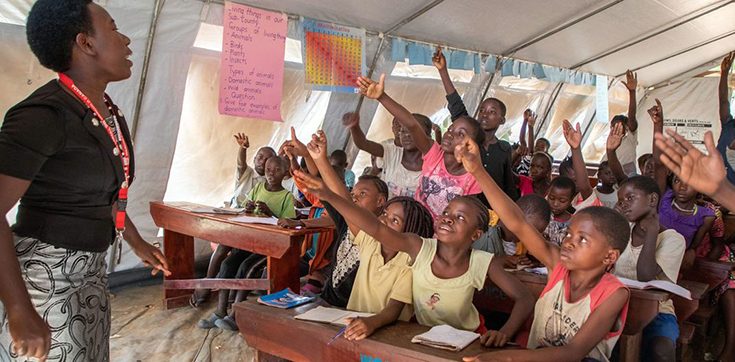A new UN report shows that women’s and children’s health has suffered globally, as the impacts of conflict, the COVID-19 pandemic and climate change converge, with devastating effects on prospects for children, young people and women.
Data presented in the report show a clear and critical regression across virtually every major measure of childhood wellbeing, and many key indicators of the Sustainable Development Goals (SDGs). Since the last Every Woman Every Child Progress Report published in 2020, food insecurity, hunger, child marriage, risks from intimate partner violence, and adolescent depression and anxiety have all increased.
‘Protect the promise’
The report, titled Protect the Promise, is published by global partners, including the World Health Organization (WHO), UN Children’s Fund UNICEF, the UN sexual and reproductive health agency, UNFPA, Partnership for Maternal, Newborn & Child Health (PMNCH) and Countdown to 2030, as a bi-annual summary of progress in response to the UN Secretary-General’s Every Woman Every Child Global Strategy for Women, Children’s and Adolescents’ Health.
An estimated 25 million children were either under-vaccinated or not vaccinated at all in 2021 – 6 million more than in 2019 – increasing their risk of contracting deadly and debilitating diseases.
Millions of children missed out on school during the pandemic, many for more than a year, while approximately 80 per cent of children in 104 countries and territories experienced learning-loss because of school closures.
10.5 million lost parents, caregivers
Since the start of the global pandemic, 10.5 million children have lost a parent or caregiver to COVID-19.
“At the core of our unkept promise is the failure to address the gaping inequities at the root of global crises, from the COVID-19 pandemic to conflicts and the climate emergency”, said UN chief António Guterres.
“The report describes the impacts of these crises on women, children and adolescents, from maternal mortality to education losses to severe malnutrition”.
Sharp decline
WHO head Tedros Adhanom Ghebreyesus, said that the COVID pandemic’s “long-term impact on the health and well-being of women, children and adolescents is becoming evident – their chances for healthy and productive lives have declined sharply”.
“As the world emerges from the pandemic, protecting and promoting the health of women, children and young people is essential for supporting and sustaining the global recovery.”
UNICEF chief Catherine Russell said the pandemic has raised the stakes for all vulnerable communities, and reversed hard-won progress for women, children, and adolescents, “but we are not powerless to change this…By investing in resilient, inclusive primary health care systems, jumpstarting routine immunization programmes, and strengthening the health workforce, we can make sure that every woman and every child can access the care they need to survive and thrive.”
Rights rolled back
“In the face of increasing political pushback against sexual and reproductive health and rights in many countries, women, children and adolescents today are left without many of the protections of just a decade ago, and many others still have not seen the progress they need,” said Dr. Natalia Kanem, UNFPA Executive Director.
The report provides wide-ranging evidence that children and adolescents face wildly divergent chances of leading a healthy life simply based on where they are born, their exposure to conflict, and the economic circumstances of their families.
Statistics tell the story
A child born in a low-income country has an average life expectancy at birth of around 63 years, compared to 80 in a high-income country. In 2020, five million children died before their fifth birthday, mostly from preventable or treatable causes.
Most maternal, child, and adolescent deaths and stillbirths are concentrated in just two regions – sub-Saharan Africa and South Asia.
More than 45 million children had acute malnutrition in 2020, a life-threatening condition which leaves them vulnerable to death, developmental delays and disease. Nearly three-quarters of these children live in lower-middle-income countries.
A staggering 149 million children were stunted in 2020. Africa is the only region where the numbers of children affected by stunting increased over the past 20 years, from 54.4 million in 2000 to 61.4 million in 2020.
The six countries with the highest numbers of internally displaced persons – Afghanistan, the Democratic Republic of the Congo, Ethiopia, Sudan, Syria and Yemen – are also among the top 10 food insecure countries.
A woman in sub-Saharan Africa has around a 130 times higher risk of dying from causes relating to pregnancy or childbirth than a woman in Europe or North America.
Millions of children and their families are experiencing poor physical and mental health from recent humanitarian disasters in Afghanistan, Ethiopia, Pakistan, Somalia, Ukraine and Yemen. In 2021, a record 89.3 million people worldwide were driven from their homes by war, violence, persecution, and human rights abuse.
The report calls on the global community to address this damaging trajectory and protect the promises made to women, children, and adolescents in the SDGs.
In particular, it advocates for countries to continue investing in health services, to address all crises and food insecurity, and empower women and young people around the world.
World Health Summit pledge of $2.6 billion to end polio
Leaders meeting at the World Health Summit in Berlin on Tuesday, pledged an extra $2.6 billion in funding toward the Global Polio Eradication Initiative’s (GPEI) 2022-2026 Strategy to end polio.
The historic boost came at an event co-hosted by Germany’s Federal Ministry for Economic Cooperation and Development (BMZ), and the funds will support global efforts to overcome the final hurdles to polio eradication.
The extra cash will help fund vaccination for some 370 million children annually over the next five years, and continue disease surveillance across 50 countries, said WHO in a news release.
“No place is safe until polio has been eradicated everywhere. As long as the virus still exists somewhere in the world, it can spread – including in our own country. We now have a realistic chance to eradicate polio completely, and we want to jointly seize that chance,” said Svenja Schulze, Germany’s Minister for Economic Cooperation and Development.
Wild poliovirus is endemic in just two countries – Pakistan and Afghanistan. However, after just six cases were recorded in 2021, 29 cases have been recorded so far this year, including a small number of new detections in southeast Africa linked to a strain originating in Pakistan.
Additionally, outbreaks of polio variants that can emerge in places where not enough people have been immunized – continue to spread across parts of Africa, Asia and Europe, with new outbreaks detected in the United States, Israel and the United Kingdom in recent months.
“The new detections of polio this year in previously polio-free countries are a stark reminder that if we do not deliver our goal of ending polio everywhere, it may resurge globally,” said WHO chief Tedros.





